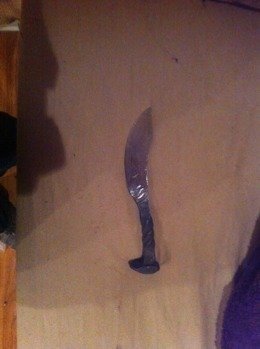So I made a deba style japanese knife for my wife for her Birthday and wanted to change a few things around and do another japanese chef knife.
Drawing and cutting out a rough shape. I ended up shortening the blade some and leaving more on the tang. This is 1/8" 1084 steel thats 2" wide. It should make a really nice all around chef knife.

Making sure the grinder is squared up.

Profile ground out

Blue layout fluid along the edge so I can use my senter scribe to see the middle exactly and it shows alot better with the layout fluid.


Working the grind line up and as it goes up im getting close to the center on the edge.

I want this knife to blend in everywhere no ricasso or sharp lines anywhere so i ground past where the edge will stop.

I dont grind to the exact center. I leave between .02" and .03". The reason for this is if it was ground all the way there is a very good chance during heat treat of some warping on the thinner metal.

Before I start blending all the grind lines in

After I start blending

Drawing and cutting out a rough shape. I ended up shortening the blade some and leaving more on the tang. This is 1/8" 1084 steel thats 2" wide. It should make a really nice all around chef knife.

Making sure the grinder is squared up.

Profile ground out

Blue layout fluid along the edge so I can use my senter scribe to see the middle exactly and it shows alot better with the layout fluid.


Working the grind line up and as it goes up im getting close to the center on the edge.

I want this knife to blend in everywhere no ricasso or sharp lines anywhere so i ground past where the edge will stop.

I dont grind to the exact center. I leave between .02" and .03". The reason for this is if it was ground all the way there is a very good chance during heat treat of some warping on the thinner metal.

Before I start blending all the grind lines in

After I start blending





























































